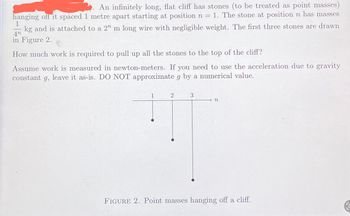Question

Transcribed Image Text:An infinitely long, flat cliff has stones (to be treated as point masses)
hanging off it spaced 1 metre apart starting at position n = 1. The stone at position n has masses
1
4n
kg and is attached to a 2n m long wire with negligible weight. The first three stones are drawn
in Figure 2.
How much work is required to pull up all the stones to the top of the cliff?
Assume work is measured in newton-meters. If you need to use the acceleration due to gravity
constant g, leave it as-is. DO NOT approximate g by a numerical value.
1
2
3
→n
FIGURE 2. Point masses hanging off a cliff.
Expert Solution
This question has been solved!
Explore an expertly crafted, step-by-step solution for a thorough understanding of key concepts.
Step by stepSolved in 3 steps with 6 images

Knowledge Booster
Similar questions
- A person carries a 50 kg object up a flight of stairs. There are ten stairs; each step is 30 cm high and 30 cm deep. How much work is done to carry the object to the top of the stairs?arrow_forwardDon't skiparrow_forwardAn electric elevator with a motor at the top has a multistrand cable weighing 6.5 lb/ft. When the car is at the first floor, 170ft of cable are paid out, and effectively 0 ft are out when the car is at the top floor. How much work does the motor do just lifting the cable when it takes the car from the first floor to the top? The amount of work required is _ft-lb.arrow_forward
- A 550 kg elevator accelerates upward at 1.2 m/s2 for the first 15 m of its motion. How much work is done during this part of its motion by the cable that lifts the elevator?arrow_forwardA tow truck pulls a car 4.30 kmkm along a horizontal roadway using a cable having a tension of 820 NN. Part A- How much work does the cable do on the car if it pulls horizontally? Express your answer with the appropriate units. Part B- How much work does the cable do on the car if it pulls at 37.0 degrees above the horizontal? Express your answer with the appropriate units. Part C-How much work does the cable do on the tow truck if it pulls horizontally? Express your answer with the appropriate units. Part D-How much work does the cable do on the tow truck if it pulls at 37.0 degrees above the horizontal?Express your answer with the appropriate units. Part E-How much work does gravity do on the car in part A? Express your answer with the appropriate units.arrow_forwardA girl on skateboard (total mass of 53.5 kg) is moving at 11.9 m/s at the bottom of a long ramp. The ramp is inclined at 18.9° with respect to the horizontal. If she travels 14.3 m along the ramp before stopping, what is the work done by the net frictional force in J on her? Give your answer to 1 decimal place.arrow_forward
- A child pulls a sled with constant speed pulling the rope at an angle of 30° to the horizontal and drags the sled for 100 m. The friction coefficient is 0.30. What work did the friction force do if the sled's mass is 5.9 kg? Express your answer with the appropriate units. W = μà Value Units ?arrow_forwardA person pushes a large box with a mass of 70 kg across a horizontal floor as shown in Figure 3. The person applies a constant horizontal force of magnitude 300 N and pushes the box a distance of 20 m. The coefficients of friction between the box and the floor are us = 0.4 and µk = 0.3. a) Calculate the work done by the person. b) Calculate the work done by friction.arrow_forwardA 100 kg block of ice slides down an incline that is 5m long and 3m tall. Someone pushes up on the block so that it slides down at a constant speed. The coefficient of friction between the ice and the incline is 0.1. What is the force exerted by the person? What is the work done by gravity? What is the work done by friction?arrow_forward
- A force of 12 Ib is required to hold a spring stretched 2 in. beyond its natural length. How much work W is done in stretching it from its natural length to 6 in. beyond its natural length?arrow_forwardA boy pulls a toboggan for a distance of 35.0 m along the snow with a rope directed 34.0° above the snow. The tension in the rope is 89.0 N. 2. a) How much work is done on the toboggan by the tension force? Hint: Work done by a constant force is given by W = Fd cos 0 Ty=Tsin@ Wy =TxD =Tcos(@)D %3D 89.0N cos(34.0)(35.0m)=+2582,5 J Imox Tx=Tcoso ニ E vedon ntenns a b) If it took the boy 43.0 s to pull the toboggan, what is the average power exerted by the boy on the toboggan? Hint: What is the relation between work, power and time?arrow_forwardA typical muscle fiber is 2cm long and has a cross-section area of 3.1x10^-9m^2. When the muscle fiber is stimulated, it pulls with a force of 1.3mN. What is the work done by the muscle fiber as it contracts to a length of 1.4cm?arrow_forward
arrow_back_ios
SEE MORE QUESTIONS
arrow_forward_ios